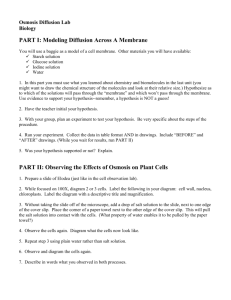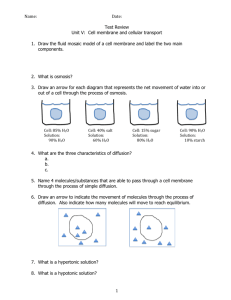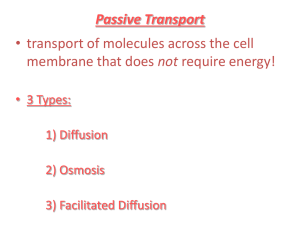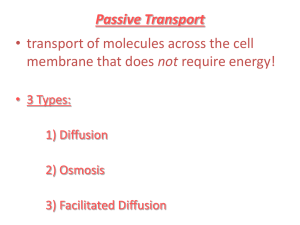Cell Membrane
advertisement
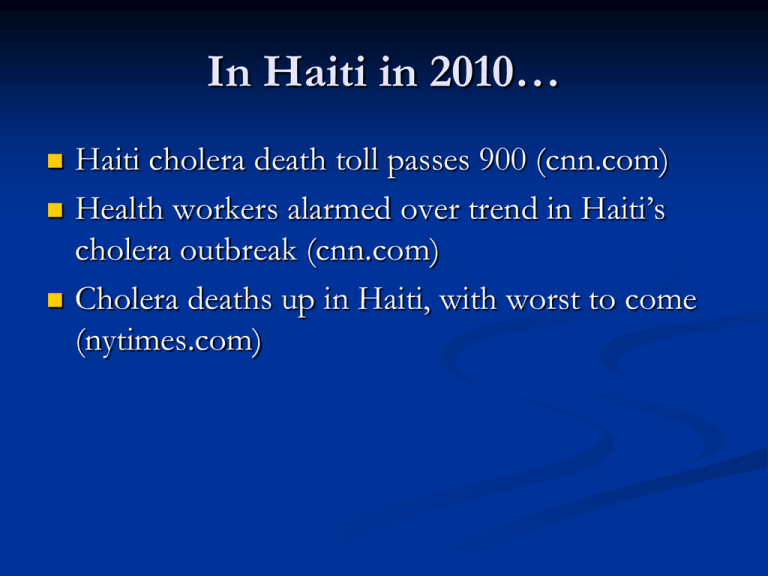
In Haiti in 2010… Haiti cholera death toll passes 900 (cnn.com) Health workers alarmed over trend in Haiti’s cholera outbreak (cnn.com) Cholera deaths up in Haiti, with worst to come (nytimes.com) You are the doctor, and you must save a cholera patient’s life. Here is what you have to work with…what would you use? Antiviral medication Antibacterial medication (antibiotics) Salt Aspirin Sugar Water Pepsi How did we do? Share how your group decided to treat the patient. What is cholera? Infection of the small intestine which is caused by a bacteria, Vibrio cholerae. Symptoms include diarrhea and vomiting, and may lead to death due to dehydration. The disease is transmitted through contaminated food and water. So…what happened? Why did some groups save their patients while other groups ended up killing their patient? The answer lies in understanding osmosis & diffusion. Osmosis, Diffusion & the Cell Membrane Two quick demonstrations Ink What is going to happen if we let this beaker sit for the rest of class? Why? Perfume If I spray some perfume in the room (don’t worry, I won’t), what is going to happen? Who will be able to detect the scent first? Why? Ever been to a party where there are a ton of people in one room? What do you do? Most likely, you spread out to another room where it is less crowded. If you were a molecule, this would be diffusion. Diffusion The movement of molecules from areas of high concentration (where there are a lot) to areas of low concentration (not so many). This explains why the perfume smell spreads throughout the room & why the ink spreads throughout the glass Requires no energy Increasing heat can speed up rate of diffusion Why does sugar dissolve faster in hot tea than in cold tea? Next question… How do you prevent a “bad guy” from breaking into your home at night? Cell Membrane Just as your house has ways to protect against unwanted visitors, the cell does too. The cell membrane is made up of phospholipids Roles: Separate the cell from the environment Control what comes in the cell & what goes out of the cell Cell Membrane The cell membrane is semi-permable Means that certain molecules can pass through the phospholipid bilayer (i.e. water) but certain things cannot Size usually plays a factor but so may other qualities, such as electrical charge i.e. I can keep burglars out of my home but I sometimes have trouble keeping ants & insects out Osmosis Many molecules are able to diffuse in and out of cells. Water is one such molecule. The diffusion of water is so important to cells that we have a special term for it. Diffusion of water across a semi-permeable membrane osmosis. During osmosis, WATER moves from an area of high concentration (where there is more water) to an area of low concentration (where there is less water) Osmosis Example Ways of Describing Solutions Solute – component of solution in lesser amount (i.e. in potato lab, it was the salt or sugar) Solvent – component of solution in greater amount (i.e. in potato lab, it was the water) 3 Ways of Comparing Solutions Hypotonic Root word means “below” Describes a solution with a lower concentration of solute than the solution across a selectively permeable membrane 3 Ways of Comparing Solutions Hypertonic Root word is above (i.e. think about “hyperactive” meaning “above active”) Describes a solution with a higher concentration of solute molecules than the solution across a selectively permeable membrane 3 Ways of Comparing Solutions Isotonic Describes solutions with equal solute concentrations on either side of a selectively permeable membrane What does this mean to cells? Skin Intestine Body Skin Salt Intestine Body Salt Salt The cholera bacteria releases a toxin that causes cells to secrete salt into the intestine. Salt Salt Salt Salt Salt So, there is a greater amount of salt inside the intestine compared to the outside of the intestine. Using what you know about osmosis, explain what happens next. Net Flow of Water Osmosis Salt Salt Salt Salt Salt Salt Net Flow of Water Salt Salt Salt Net Flow of Water Salt How would you treat the patient using osmosis? Cell Membrane Structure Made of two layers (lipid bilayer) Gives cell membranes a flexible structure that forms a strong barrier Contains protein and carbohydrate molecules Helps materials cross the membrane Cell Membrane Structure Phospholipid Proteins embedded in bilayer Hydrophobic tail; Hydrophilic head May act as channels Carbohydrate chains Cellular identification Like a flag Facilitated Diffusion Cell membrane has certain channels (proteins) that make it easy for certain molecules to cross the membrane Will only occur if there is a higher concentration on one side of the membrane Back to that party… What if you wanted to move from the empty room to the crowded room? It would require energy on your part to fight your way through the crowd. Active Transport Sometimes it is beneficial for cells to move certain molecules “against the tide” From areas of low concentration to areas of high concentration This requires cells to use energy The cell has to use ATP (energy currency of the cell) in order to make this happen Active Transport Small molecules and ions are carried across membranes by proteins Endocytosis Requires energy, cells use majority of their energy for transport Process of taking material into the cell by folding of cell membrane Exocytosis Membrane of vacuole fuses with cell membrane forcing contents out of cell Wrap-Up Question, 10/13 Compare/contrast diffusion with active transport. Wrap-Up Question, 10/15 What did you expect to happen with the eggs? How did the actual results compare with your prediction?
